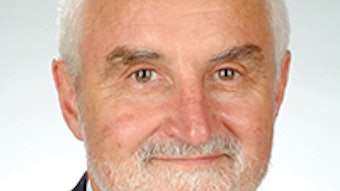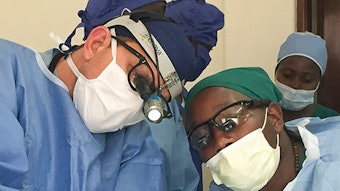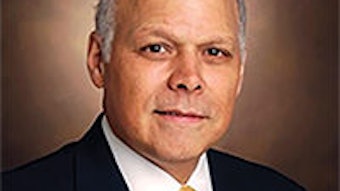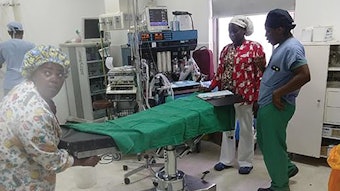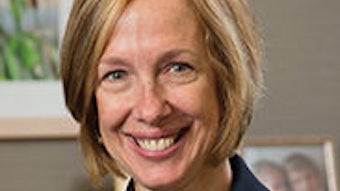Bringing Together the World of Otolaryngology Virtually with the 2020 International Regional Roundtables
During the AAO-HNSF Annual Meeting & OTO Experience, the International Advisory Board (IAB) General Assembly includes Regional Roundtable Discussions representing Africa, Asia-Pacific, Europe, the Middle East, and Latin America. Attendees from these geographic regions share ideas, best practices, and insights on issues facing the specialty.

Please note: Due to the changing circumstances of the COVID-19 pandemic, please keep in mind that these reports are reflective of current situations as of August/September.
Africa
Led by Anna Konney, MD, FWACS, FGCS; with Chenge Macharia, MBChB, FCS (ECSA); Gayle E. Woodson, MD, AAO-HNS/F Past President; Mark E. Zafereo, Jr. MD, AAO-HNSF Coordinator-elect for International Affairs; and Johannes J. Fagan, MBChB, FCS(SA), Past IAB Chair.
 Gayle E. Woodson, MD
Gayle E. Woodson, MDThe African Regional Roundtable piggybacked onto a Tumor Board Meeting of the African Head & Neck Society (AfHNS). The AAO-HNSF discussion followed clinical cancer case presentations by speakers from Cape Town, South Africa, Uganda, and Ghana. The following report was submitted by Dr. Woodson:
Returning to practice guidelines and practice changes in the COVID-19 era:
The severity of the COVID-19 pandemic, and hence its impact on clinical practice, varies greatly throughout Africa. For example, South Africa has been the hardest hit country in the continent. Other countries have been minimally affected, leading some to suggest that the disease has been under-reported. However, the clinical experience reported by participants on the call confirmed that the disease burden is relatively low in countries such as Kenya and Tanzania. Possible reasons include the youthful population, a warmer climate, and possible prior exposure to some other diseases that are not present in the West.
Training and education during the pandemic and beyond:
All participants agreed that the use of virtual meetings is a fortunate byproduct of an unfortunate situation. Otolaryngologists from Africa have appreciated the opportunity to participate in online sessions that were organized to replace in-person meetings. Participants in the Roundtable feel strongly that online education should continue and be expanded.
Asia Pacific
Chaired by Sheng-Po Hao, MD, with Joseph K. Han, MD, and Elizabeth H. Toh, MD. The following report was submitted by Dr. Toh:
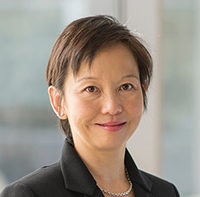 Elizabeth H. Toh, MD
Elizabeth H. Toh, MDReturning to practice guidelines and practice changes during COVID-19 pandemic:
Many countries have returned to seeing patients in the clinic and performing elective surgeries in June and July under the guidance of their local/regional ENT societies, hospitals, or government. Most countries have adopted a variety of engineering and non-engineering controls within their hospitals to protect patients and hospital workers. PPE recommendations vary by country to generally reflect the risk of exposure, with all using full PPE for aerosol-generating procedures. Preop COVID-19 testing was being performed in most institutions, with Japan additionally requiring patients to isolate for two weeks prior to their procedure. New Zealand requires patients to be tested for COVID-19 prior to being seen. Korea is testing all inpatients. New Zealand and Taiwan have had impressively low numbers of COVID-19 cases and related deaths during this pandemic, which they attribute to very strict government guidelines. Some countries, such as Japan, are experiencing a second wave in COVID-19 cases in metropolitan areas, necessitating local changes in policies to restrict clinical activities.
Training and education during the pandemic and beyond:
Webinars and virtual meetings were used for didactics. There was generally a reduction in patient contacts and surgical cases for trainees during the pandemic, but no changes were made to training programs except in the Philippines where training has been extended for up to one year. Exams in Singapore have been postponed, and international fellows were not allowed entry in Taiwan. Korea adopted simulation techniques for surgical training.
Europe
Chaired by Maria V. Suurna, MD, and Cem Meco, MD, CEORL. The following report was submitted by Dr. Suurna:
 Maria V. Suurna, MD
Maria V. Suurna, MDReturning to practice guidelines and practice changes in the COVID-19 era:
Each country had its own regulations guided by the government entities. European countries were faced with initial shortage of PPE, but at the present access to PPE is no longer a problem. Patient care has resumed in most countries with modifications to meet the requirements for patient and physician safety. However, in some European countries the numbers of COVID-19 cases continue to rise. As a result, many patients are afraid to come to the hospitals and seek medical care at the physician’s offices, thus delaying their care. This raises a potential public health concern that patients will be presenting with more advanced medical and oncologic diseases. There is a need to find a solution for gaining patients’ confidence and assuring them that it is safe to seek medical care.
Training and education during the pandemic and beyond:
Medical student education and resident training have been significantly affected. Medical education has transitioned to a virtual format, and the absence of in-person teaching, sharing practical knowledge, and development of hands-on skills is presently the main challenge for medical student education and resident training. Access to online education resources has been essential for teaching, and efforts are being made to further develop and utilize these resources. Cadaver courses have not been available during this time. During the peak of pandemic residents were not allowed in the operating rooms. In addition, the number of daily surgical cases has been significantly lower due to longer operating room turnover and time requirements between the cases.
Latin America
Chaired by Jacqueline Alvarado, MD, and Geraldo St’Anna Druck, MD. The following report was submitted by Dr. Alvarado:
 Jacqueline Alvarado, MD
Jacqueline Alvarado, MDReturning to practice guidelines and practice changes in the COVID-19 era:
Argentina experienced a long quarantine and is just now starting to return to practice following guidelines from the AAO-HNS as well as British and Spanish ORL Societies. In Brazil physicians are still being cautious, requiring preop COVID-19 testing for all surgical patients. Since the pandemic, there have been significant changes in the physician’s workflow in Mexico, causing disruption, but the implementation of guidelines has allowed them to continue to work.
Training and education during the pandemic and beyond:
In Ecuador virtual learning for all the residents has been highly successful with Zoom meetings sponsored by pharmaceutical companies. At first about 300 individuals were participating, but once things went back to normal participation slowed. Colombia experienced a very long quarantine with significant hurdles to go through for education with all in-person academic activities stopped through July 2021. This has caused significant disruption in medical education. Virtual meetings are beneficial but no replacement for in-person interactions. Virtual education has also been utilized in Mexico to replace in-person events through FESORMEX (Federation of Mexican Society).
Middle East
Chaired by Muaaz Tarabichi, MD, with Soha N. Ghossaini, MD, and Ahmed M. S. Soliman, MD. The following report was submitted by Dr. Soliman:
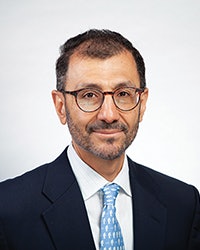 Ahmed M. S. Soliman, MD
Ahmed M. S. Soliman, MDReturning to practice guidelines and practice changes in the COVID-19 era:
Many countries in the Middle East are still in peak or have just recently reached peak. Many are still on lockdown (Iraq) while others are just beginning to open up albeit slowly (Saudi Arabia). Many are still on lockdown. Access to PPE has not been a major challenge. Egypt, for example, converted textile factories to produce PPE. Preop testing of patients for COVID-19 varies even within some countries (Saudi Arabia), where some test 100% of patients and others only test when the patient is symptomatic. Testing for healthcare workers also varied but was not routinely mandated among the countries.
Training and education during the pandemic and beyond:
Most of the otolaryngology residents were not working during the peak of outbreak, and tests and exams were postponed. Several countries noted concern about case numbers and clinical/surgical experience, and as a result, modifications of requirements were made in some countries.

